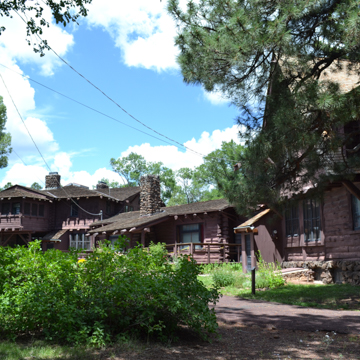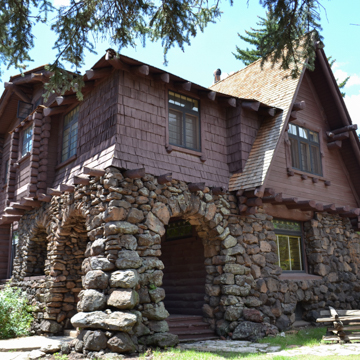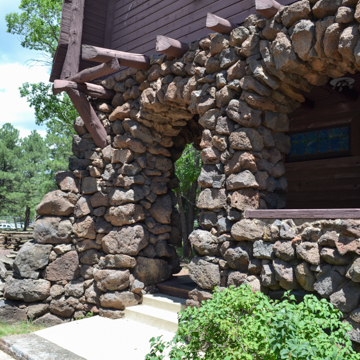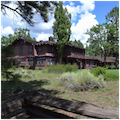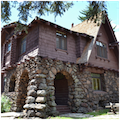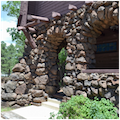You are here
Riordan Mansion
Located in a stand of Ponderosa pine adjacent to Northern Arizona University, the Kinlichi Knoll Estate (named for the hill on which it is situated) contains two nearly identical and connected houses built in 1904 for the owners of the Arizona Lumber and Timber Company, brothers Timothy and Michael J. Riordan, their wives (who were sisters), and their combined seven children. The rustic houses of the estate was designed by Charles Frederick Whittlesey, architect of the Grand Canyon’s El Tovar Hotel (1903–1905), with input from the Riordans, who shaped Flagstaff’s fin-de-siècle economic and political development. Kinlichi Knoll is among the best examples of Craftsman architecture in Arizona and it has many of the stylistic hallmarks of this American version of the Arts and Crafts movement.
Sons of a carpenter, Michael (1865–1931) and Timothy (1858–1946) followed their elder brother Denis Matthew (1848–1928) from Chicago to Flagstaff to work in his lumber milling business circa 1887. Within a decade, Denis sold the firm to his younger brothers and relocated to California. While Timothy was doing business with the Atchison, Topeka and Santa Fe Railway in 1903, he made the acquaintance of Whittlesey, the railroad’s Albuquerque-based chief architect. Originally from Illinois, Whittlesey had worked as a draftsman for Louis Sullivan in Chicago before joining the railroad in 1900. When he met Riordan, he was conceptualizing the El Tovar Hotel, which would subsequently influence his designs for the brothers’ houses.
Whittlesey’s design for the dual residence utilized a full range of the Riordans’ commercial products, including full-dimension, two-by-six frame construction covered by log slab, wood shiplap, and shingle siding; hand-split shake roofing on wood-plank sheathing supported by wooden beams and logs; and hardwood (maple) floors. Locally quarried volcanic Malpaís rock in the lower level anchored the expansive structure to its natural setting. Whittlesey masterfully combined rustic elements with Arts and Crafts design principles, prioritizing the use of natural light, emphasizing natural ventilation, and employing materials in an “honest” fashion. Significantly, Whittlesey’s design predates by four years Charles and Henry Greene’s Gamble House (1908) in Pasadena, which is considered the epitome of Arts and Crafts architecture in America. Established in Britain through the work and philosophy of William Morris and others, the Arts and Crafts movement swept through the United States at the turn of the twentieth century. Popularized in America by Elbert Hubbard’s Roycroft community (established near Buffalo in 1895) and Gustav Stickley’s The Craftsman magazine (founded in 1901), Arts and Crafts design emphasized simplicity, economy, and use of natural and local materials. The Arts and Crafts ethos appealed to the Riordan brothers, who were educated and ambitious, but also humble and religious.
The mansion (originally the centerpiece of a 47-acre estate) is essentially a double house with forty rooms and 13,000 square feet. It consists of a pair of two-story wings (6,000 square feet each) that are connected by a 1,000-square-foot, single-story “rendezvous room” detailed like a rustic cabin with a large fireplace and a billiards table. It also features distinctive decorative windows that Michael helped design using photographs by John K. Hilliers, who documented the Southwest as part of numerous federal surveys (including John Wesley Powell’s Grand Canyon expeditions of the 1870s). In the “rendezvous room” each window consists of two large-scale landscape photographs mounted below five smaller portraits of Native Americans. These were fabricated by binding Hilliers’ black and white transparencies to frosted glass (restored in the 1980s), creating a luminously regional atmosphere in the room.
Throughout the house Whittlesey’s design features beamed ceilings and custom-designed electric light fixtures, with bathrooms on both levels. In addition to linoleum flooring in the kitchens, each house has built-in shelves and cabinets, wainscoting, window seats, and multiple fireplaces with inglenooks—all indicative of the Arts and Crafts style. In keeping with the overall aesthetic, the house also contains a large collection of original Arts and Crafts furniture, including many pieces by Gustav Stickley.
Timothy and his family occupied the east wing while Michael and his family lived in the west. Although mirror images of each other, the floor plans and exteriors of the two houses have minor variations: a rectangular dining room in the west wing was transformed into an elliptical counterpart in the east; the east wing has a more elaborate skylight and ventilation system; and there are subtle differences in rooflines between the two cores. An upstairs sleeping porch was added to the west wing in 1914.
The Riordan Mansion and five surrounding acres are now an Arizona state park managed by the Arizona Historical Society.
References
Durham, Michael S. Smithsonian Guide to Historic America: The Desert States.New York: Stewart, Tabori and Chang, 1990.
Patterson, Ann, and Mark Vinson. Landmark Buildings: Arizona’s Architectural Heritage.Phoenix: Arizona Highways, 2004.
“Riordan Mansion State Historic Park.” Arizona State Parks. Accessed August 9, 2014. http://azstateparks.com/.
Rothweiler, Thomas S. and Marjorie H. Wilson, “Riordan Estate,” Coconino County, Arizona. National Register of Historic Places Inventory-Nomination Form, 1979. National Park Service, U.S. Department of the Interior, Washington, D.C.
Writing Credits
If SAH Archipedia has been useful to you, please consider supporting it.
SAH Archipedia tells the story of the United States through its buildings, landscapes, and cities. This freely available resource empowers the public with authoritative knowledge that deepens their understanding and appreciation of the built environment. But the Society of Architectural Historians, which created SAH Archipedia with University of Virginia Press, needs your support to maintain the high-caliber research, writing, photography, cartography, editing, design, and programming that make SAH Archipedia a trusted online resource available to all who value the history of place, heritage tourism, and learning.















